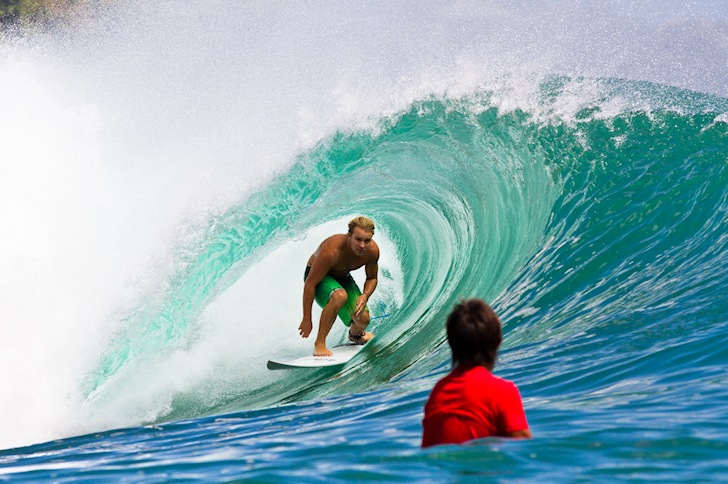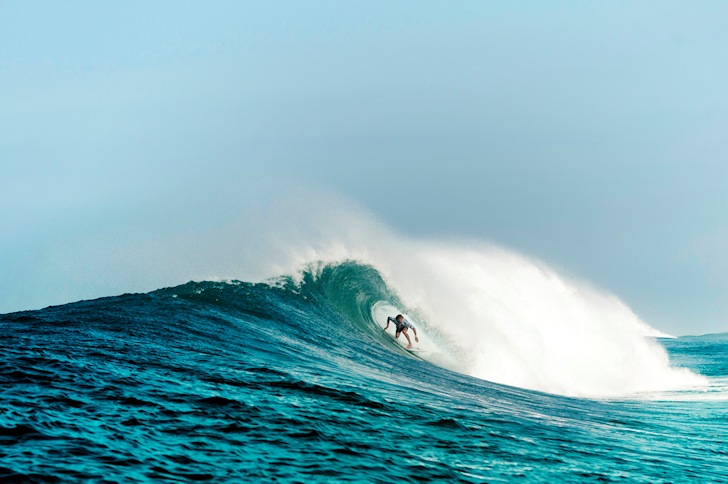There's a stoked little tube rider in all of us just waiting to drop in. Gliding along inside the hollow of a perfect peeling wave and emerging triumphant from its natural rolling end is one of the first fantasies to capture the surfer's spirit.
Surf spots that produce good, clean barrels can get wild, so it's a good surf practice to prepare yourself with some know-how before you go.
The general consensus on tubing it for the first time is to go frontside.
That way, you avoid any inner spray rushing at your face, and you can reach a hand out to the body of the wave if you need a little balance.
With that in mind:
Paddling Equals Speed
It's essential that you have enough speed to get down the wave and through the barrel before it closes off. So, paddle as efficiently as you can.
Crouch and Drop Shallow
Since you're just getting started, we'll assume your first attempt at a barrel isn't monstrous. So get your turn on pretty much straight away.
A nice, tightly-angled, crouched drop-in is a solid starter technique. It means you're more likely to get moving just ahead of the lip, putting you in the perfect position.
Stay Centered
Once inside, stay centered. You have to become what you essentially are in there: a projectile.
Don't risk ricocheting by touching the top or the bottom. Get in the middle and go!
Try to Stay Above the White Stuff
It's got its own velocity and is super hard to move on. It'll either slow you down and get you closed out or throw your line off and make you eat it.

Knees Bent Deep, Back and Ass in a Straight Line
Inside the tube, there's not a lot of room to maneuver, so keep your adjustments as finely tuned as possible.
It really does work. And keep up that speed! You're going to need it. So, use your toes and ankles to pump.
It's Like a Camera
Once inside, keep your eyes on the end of the tube.
Imagine it's like a camera lens, and try to keep it roughly the same size as you move. If it starts to look small or tight, I pump for speed.
Watching the top of the edge can give a good indication of what the wave wants to do. Sharper angles can mean it's ready to die, so stay close.
Exit Strategy
Ideally, you won't have to think about this one.
The wave will naturally close off just as you come gliding out of the end, and you can double back over the wave and paddle for another.
But a lot of different factors can affect how a wave behaves. It can happen suddenly, too, so have a plan in case something changes.
Bailouts in a barrel aren't as intuitive as on an open wave, as you have fewer movement options.
An old trick is to pull a projected fall back and through the side of the wave by tucking your head to the shoulder and pushing the board forward with your feet.
Other surfers prefer to dive straight forward and pull a sharp turn under the wave towards the back.
Study the Ocean
And just in case you're the curious type, know your ocean.
You don't have to be a marine biologist to surf well, but it helps to understand what types of conditions set a surfer up for great rides.
You already know that offshore winds provide the right type of counter-pressure and help shape incoming waves into smooth, glassy temptresses, so watch what the weather's up to.
Similarly, knowing what's under the water can help you predict what kind of waves you're likely to get.
A gently sloping seabed is a lot less likely to bring in tubes than a quick deep drop - which kicks the waves up suddenly when it breaks on the shallow shelf - is.
Discover how surfers perceive time in the barrel.
